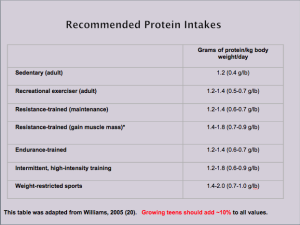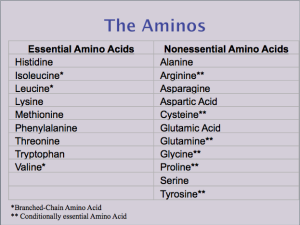What is protein?
Proteins are different sequences of amino acids that are held together by peptide bonds and contain at least one nitrogen atom. They are found in every cell of the body! Proteins have various functional roles from general growth and maintenance to acid-base balance to hormones to transportation of other molecules. Proteins are extremely important for overall health, and particularly important for developing athletes. They promote muscle and connective tissue growth, the formation of antibodies to strengthen the immune system, and they are the foundation of hormones, enzymes, and blood cells. Although protein is only broken down for energy in starvation situations, protein metabolizes to produce four calories per gram. The recommended percentage of protein intake is 10-35% of one’s diet (see Figure 1).
The Essentials
As stated, proteins are composed of amino acids: some of which are essential, and can only be obtained through proper eating; and some of which are non-essential, and can be formed from other substrates (see Table 1). A food protein is considered “complete” if it contains all nine essential amino acids. Examples include milk, eggs, meat, poultry, and fish. Food proteins that lack one or more essential amino acids are considered “incomplete,” meaning that they are incapable of causing growth. If eaten in isolation, incomplete proteins can lead to protein malnutrition. Examples of incomplete proteins include plant proteins such as corn, lentils, beans, and nuts.
(Table 1)
So…how does this apply to me?
NO nutrition labels will tell you which amino acids are in a particular food. It takes a lot of time, energy, and resources to calculate out how much of an amino acid is in a food, and then determine its digestibility in order to explain whether or not one source of protein is “better” than another. But you can be smart about your protein intake! The more physically active you are, the more protein you will need; however, this is based on your body weight as well. Table 2 shows the recommended grams of protein per kilogram of body weight per day for individuals at different activity levels. Note that growing teenagers should add about 10% to their values, as they are also secreting more hormones and developing more quickly than adults.

( Table 2: Differences in Protein intake based on goals).
Most people do not like to spend the time counting out the number of grams of protein they consume in a day, but you don’t need to do that! Usually, making sure that 10-35% of your meals are composed of complete proteins will be sufficient for your recommended daily intake. If you are aware that your protein intake is less than normal, or have special dietary restrictions, protein supplements are available. Keep in mind that these are meant to supplement your diet, and are not intended to replace all protein. A nutritionist or health fitness specialist should be consulted about finding the right supplemental protein for your needs.
Many other factors play into how your body processes and utilizes protein, but we’ll touch on those at a later date. For now, become aware of your protein intake!
Erin Blaser, BA (University of North Carolina Chapel Hill ‘15), NASM-CPT


